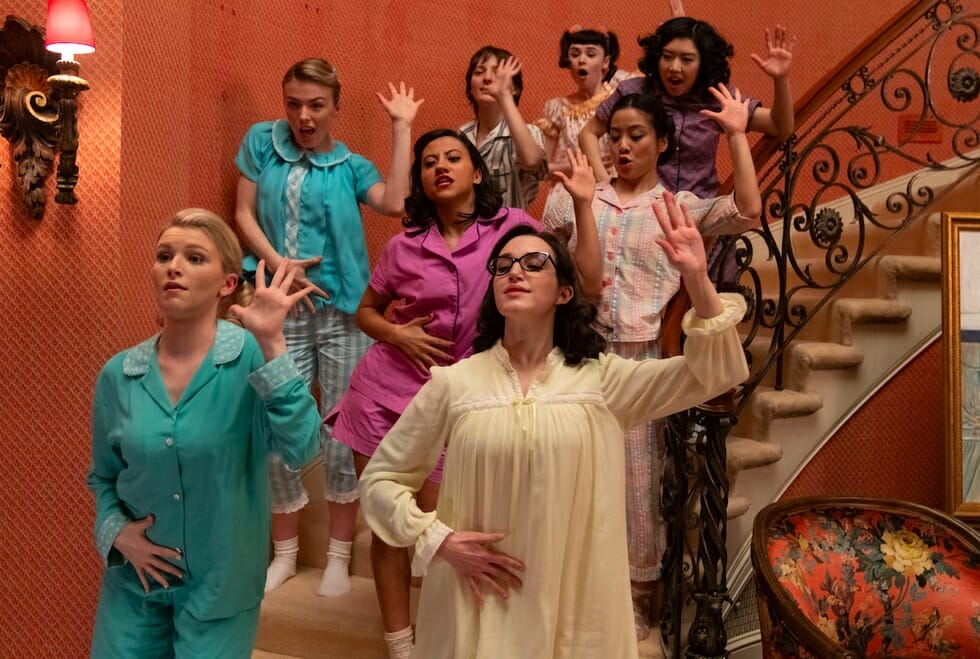
Words by Marie-Claire Chappet
As Yellowjackets returns and The Rise of The Pink Ladies debuts, we examine the power of on-screen female friendships
“Watch out fellas,” a 1950s student sarcastically extols in the latest trailer for new Paramount show, The Rise of The Pink Ladies. “It’s a girl gang.”
The release of this unexpected Grease prequel coincides with the arrival of the second series of the hugely popular Yellowjackets. Both, in their disparate ways, tackle the dynamics of a female friendship group; a ‘girl gang’. Sure, one does so through big musical numbers and the other through a cannibalistic survival cult but, well, representation is representation.
Because that’s the thing. Seeing honest and bold depictions of female friendships is still a rarity on screen. Why else, after all, was the infamous Bechdel test – whereby films are rated based on how many times women speak to each other (and not about a man) – devised? Only recently, a joke montage circulated online of all the moments in The Lord of The Rings franchise when two female characters interact. In all nine hours of footage, it was one scene: in which a little girl asks “where is mama?” to an unnamed woman. That was it.

“When Thelma and Louise came out it was revolutionary,” says Helen O’Hara, the film critic and author of the book Women vs Hollywood: The Rise and Fall of Women in Film . “But that was because from the 1970s onwards there had been this almost eradication of women on screen in that way. The weird thing is, there were more of those kinds of stories told in the 1930s and 1940s, like Dance Girl Dance, which had a female director and starred Lucille Ball. Even How to Marry a Millionaire and Gentlemen Prefer Blondes are absolutely grounded in the strong central female friendships.”

Getty Images
Indeed, what both The Rise of The Pink Ladies and Yellowjackets demonstrate is that there is an appetite for female-driven narratives which has too-often been overlooked. As O’Hara notes, the misdirection of Hollywood towards male-dominated films became a self-fulfilling prophecy. The more films were not catered towards women, the less women attended the cinema and the de facto target audience for Hollywood became male. This hugely impacted the way we ascribe value to cinema, something we are still grappling with today.
“We still treat women’s stories as being less important than men’s”
“I think we still treat women’s stories as being less important than men’s,” says O’Hara. “Think of how many films there are about father complexes and the father-son relationship, as opposed to mother-daughter relationships. And it’s similar with friendships; we treat a story about male bonding like Top Gun as iconic and films like Steel Magnolias or Beaches as melodramatic chick flicks.”
Television was one of the greatest revivers of the female friendship narrative and O’Hara notes that, in our current creative climate, where everything is a spin-off or prequel or reboot of existing intellectual property, it is encouraging that the Grease ‘universe’ has opted to focus on its iconic girl gang. TV’s backing of female narratives probably largely began (the legendary Golden Girls aside) with Sex and the City – a game-changer not just because of the radical way it spoke about women’s sexuality in the 1990s, but in the way it pushed a girl gang to centre stage. It spawned so many similar shows, from Girlfriends to its millennial inheritor Girls, which took the SATC template and made it rougher and more complex. While And Just Like That is continuing the narrative into the characters’ sixth decade (doing for our fifties what Grace and Frankie did for our eighties), HBO Max reports that viewing figures for Girls have risen, and indicate that a whole new generation is discovering it. But how realistic are these depictions?

Getty Images
Claire Cohen, author of BFF? The Truth about Female Friendship believes that, for too long, the dynamics of women have proven a mystery to typically all-male writing rooms and executive boards. “I genuinely think that TV commissioners don’t know how to handle female friendship a lot of the time – the easiest way is via comedy, of course, and that’s where we’ve seen SATC, Girls and Broad City extended over multiple seasons. In a space where you can crack jokes, you don’t always have to explore the deep drama, heartbreak and emotion that is present in groups of female friends and which we rarely see truly unpicked on screen – despite being central to many of our lives. Maybe our friendship groups have just been seen as too complex to touch or too messy to sustain successful shows in the long run. Which is kind of sad if you think about it.”
Cohen observes that often what we are presented with are clichés about female best friends that skim over the vital dramatic weight of these relationships. “Most of them can be summed up as women either being BFFs – ruled by some unspoken ‘girl code’ and who unquestioningly have each other’s backs – or the total opposite: catfighting enemies,” she says. “It’s so reductive and turns the most important platonic relationships of our lives into a shallow stereotype.”
“We need to see more unlikeable women on TV”
The tides are, however, turning, particularly with the rise in more women behind the camera, in the producer’s chair and writing those scripts – from Reese Witherspoon and Ilana Glazer and Abbi Jacobson, to Sharon Horgan, whose Bad Sisters was, though familial, a masterclass in female dynamics. While there were moments of emotional heft in SATC, Dunham’s Girls was a true gear-change in the way it leant into the thorniness of female friendships, the often-unspoken resentments and competition, the quiet judgements and unbridled love flashing through with equal, very human, brightness.
Though set in the extremes of the Canadian wilderness post a devastating plane crash, Yellowjackets does this with a brilliant degree of nuance. It levies equal weight to the relationships between these women in their forties as their teenage selves, and gives as much attention to the unspooling relationship between two central best friends as it does to whether they all eat each other by the end. Indeed, suspected cannibalism aside, the show is brilliantly audacious in its portrayal of flawed women.
“I strongly believe we need to see more unlikeable women on TV,” says Cohen. “And when I say unlikeable, I mean real – because don’t we all do things to hurt, anger or disappoint our friends sometimes? Don’t we all act out of hurt, jealousy, guilt or shame? I’d much rather see those sides of female friendship than a picture-perfect model of a girl squad. That’s just a toxic fantasy. Give us the dark sides and the ridiculous joy, too. Then maybe we’ll be getting there.”
With the mammoth success of Yellowjackets, and dozens more female-led shows popping up with promising regularity: it seems like “watch out fellas” is the right reaction…
This article originally appeared in harpersbazaar.com



